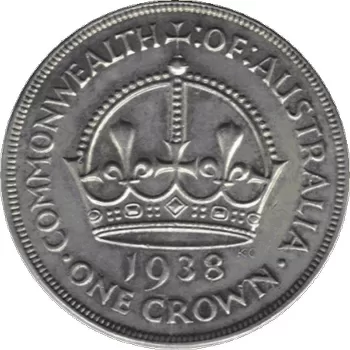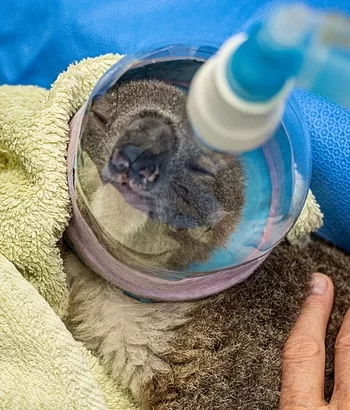The Australian Crown, a coin used in the Commonwealth of Australia before the shift to decimal currency in 1966, was issued in only two years, 1937 and 1938.
It shared a similar size and weight with the British Crown and was crafted from sterling silver for both of its production years. Just like its British counterpart, the Australian Crown had a face value of five shillings.
In total, 1,008,000 Australian Crowns were minted in 1937, whereas only 101,600 were minted in 1938, making the latter significantly more valuable in today’s collector market.
1937 Australian Crown: The 1937 Australian Crown featured a portrait of King George VI on the obverse side and the Australian coat of arms on the reverse side. It was a non-commemorative issue and part of the regular coinage.
1938 Australian Crown: The 1938 Australian Crown was issued to commemorate the sesquicentenary of British colonization in Australia. It also featured a portrait of King George VI on the obverse side and the Australian coat of arms on the reverse side.
The crown had a face value of five shillings, which was 1/4 of a pound and 60 pence. It was a relatively large and high-denomination coin in the pre-decimal currency system. The coins weigh an impressive 28.27 grams (436.3 grains), contains 0.8411 oz of silver and is 38.5 mm in diameter.
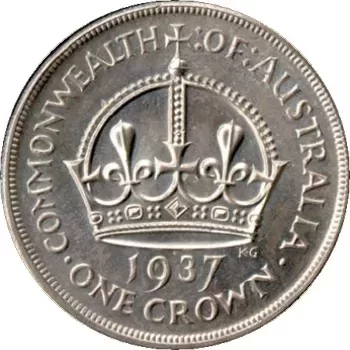


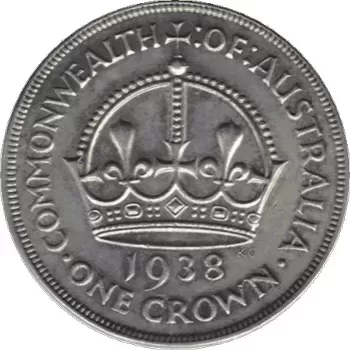

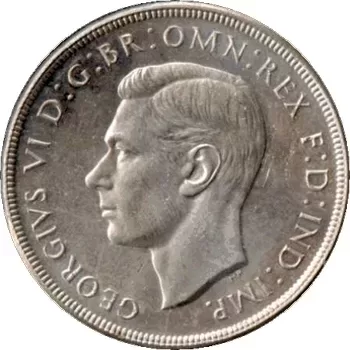

The obverse was designed by Thomas Humphrey Paget, and the reverse was designed by George Kruger-Gray.
A King abdicates
Originally, the Crown was meant to commemorate the ascension to the throne of King Edward VIII.
In the early days of December 1936, a constitutional crisis was ignited within the British Empire by King Edward VIII’s intention to marry Wallis Simpson, an American socialite who had previously gone through divorce with her first husband and was in the process of divorcing her second.
This proposed marriage faced strong opposition from the governments of the United Kingdom and the various Dominions of the British Commonwealth. The objections were multifaceted, encompassing religious, legal, political, and moral concerns.
Of particular significance was the fact that, as the British monarch, Edward held the nominal position of the head of the Church of England. At that time, the Church did not permit divorced individuals to remarry in a church ceremony if their former spouses were still alive, adding a layer of complexity to the unfolding crisis.
Edward could not marry Simpson and remain on the throne, and he abdicated in December 1936.
Following this extraordinary turn of events, the 1937 Australian Crown was instead minted to mark the ascension of King George VI. The Crown lost popularity rather quickly resulting in the discontinuation of its production.
The Crown’s value as a collector’s item
Australian crowns are no longer in circulation and have become collectible items. Collectors are drawn to them for their historical significance, intricate designs, and the fact that they represent an important era in Australian coinage.
The value of Australian crowns depends on factors such as their condition, rarity, and collector demand, with commemorative crowns often being more sought after by collectors.
The Australian crown was notorious for its large size and weight that led to numerous bag marks and rim nicks. Following the striking process, the coins were conveyed and dropped into a collection bucket, often resulting in tooth marks from the reeded edge of another crown. Locating a 1937 or 1938 crown without any marks is exceptionally rare.
Fake counterfeit Australian Crown coins
Yes indeed, there are counterfeit Crown coins, such as this one in the Powerhouse. It seems they are originating in China and sold on eBay using various aliases. The genuine Crown is very close to 28.28 grams. Fake coins can sometimes be magnetic due to plating.
Australian Crowns mintage
| Year | Mint | Mintage | Mint Mark | Cond. | Value | Comments | Cond. | Value |
| 1937 | Melbourne | 1,008,000 | – | Unc | King George VI | Unc | ||
| 1938 | Melbourne | 101,600 | – | Unc | – | – | – |
What to look for when grading a Crown coin
By following this comprehensive grading process, you can accurately determine the condition of 1937-1938 Australian Crowns and make informed decisions when buying or selling these coins. This approach helps ensure a reasonable price based on the coin’s wear, rather than relying solely on the seller’s persuasion tactics.
For 1937-1938 Australian Crowns, here is a detailed grading procedure:
The Reverse of the Crown Coin
Start by examining the reverse side of these coins. Focus on the top of the crown, where there is a cross with a circle, known as the ‘Orb.’ Within this circle, look for a very light cross formed by one vertical and one horizontal band, and assess whether there is any wear on this cross.
The reverse of the coin features a crown, and “COMMONWEALTH OF AUSTRALIA 1937 ONE CROWN”



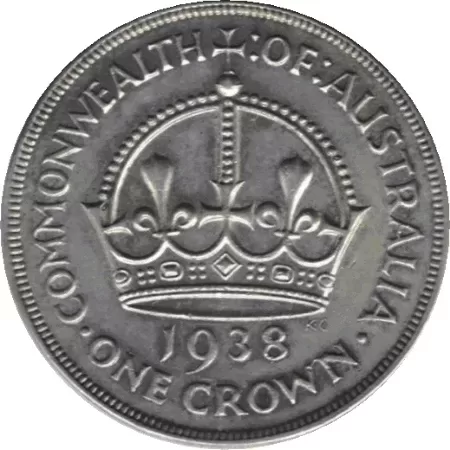

Pearls and Spire of the Crown coin: Move on to inspect the nine pearls lined up vertically below the Orb. Check whether these pearls appear rounded or if there are signs of flattening. Next to the pearls, there are vertical lines known informally as ‘Spires,’ each with a raised line down the center called a ‘Flute.’ Examine these Flutes for wear.
Examine Rims and Denticles: Scrutinize the rims and denticles for any signs of wear, rim ricks, chips, bumps, or bruises.
Determining UNC Grade: If there is absolutely no wear on these high points, it is advisable to use a magnifying glass for a thorough check. If no wear is found, particularly on the reverse side, the coin may be graded UNC (Uncirculated).
Before assigning the UNC grade, assess the fields and designs on both sides of the coin. Look for scratches, wear, abrasions, and porosity of the surface, as coins can develop indentations during transportation.
1937 and 1938 Crowns were commonly transported to banks and could acquire ‘Bag Marks’ due to their large size. If the coin exhibits only bag marks and no other wear, it can still be considered UNC. The coin’s description might indicate “UNC with bag marks” or “UNC with rim nicks.”
However, if the coin lacks full lustre, even under surface patina or toning, it should be graded downward.


Obverse of the Australian Crown coin
Examine the obverse side of the coin, focusing on the King’s features.
Check the King’s hair, top of the ear, eyebrow, nose, jawline, and neck. Assess whether the combing lines in the hair are clearly visible, if the eyebrow shows any flattening, if the earlobe exhibits wear or damage, and whether there are marks in the field.
Also, inspect the rims and legends on this side.
You may find the serif entirely absent from the upper right stem of the letter X in “REX.” Additionally, the initials “HP” under the neck may lack complete formation, and certain areas of the letters “B” and “R” in the legend may appear uneven or irregular.
The obverse of this coin features an uncrowned bust of King George VI facing to the left and the legend “GEORGIVS VI D: G: BR: OMN: REX F: IND: IMP” (meaning ”George VI, King of all the Britains, Defender of the Faith, Emperor of India’).
Anniversary issues
In 1997, the Perth Mint commemorated the 60th anniversary of the issuance of the 1937 crown by introducing a 2-ounce silver bullion coin with a special privy mark.
In 1998, the Canberra Mint issued a frosted proof coin with a denomination of Fifty Cents, made from .999 silver. The coin featured a reverse design created using a modified die originally employed for producing the reverse of the 1937 crown, paying homage to this historical numismatic piece.
We use the following grading system, used internationally to conservatively grade our tokens and coins:
Unc = Uncirculated EF = Extremely Fine VF = Very Fine
F = Fine VG = Very Good G = Good P = Poor
Further Reading
Pirate Guide to Collecting Australian Coins: 2023/2024 Edition, November 2, 2023 by Damian Walker
Renniks Australian Coin & Banknote Values 31st Edition Hardcover
A Guide Book of United States Coins 2022 75th Edition Spiral-bound by Garrett, Jeff, Bowers
Paper Money – North America – Australia – Oceania: COLOR PHOTOGRAPHY Paper money – Old and Rare Banknote (Banknotes of the world)
Related stories
The story of the NSW Rum Corp, Holey Dollar and Dump coins
The Top 20 rarest and most valuable US coins
The intriguing tale of the 1933 Double Eagle gold coin
Numismatics: Fake Coins to Watch For
Explore the Art of Belly Dancing
Police Ephemera ° The value of Victorian reward posters
‘Central Bank Digital Currency’ is a new digital form of money issued by RBA
What are the world’s largest and famous gold nuggets?

